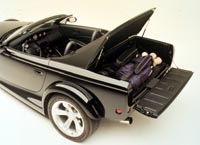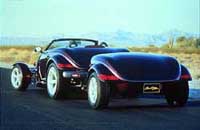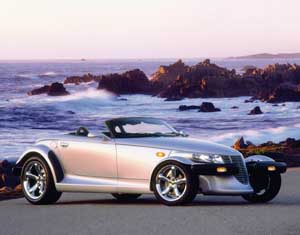 Now into its fourth model year, the 2000 Prowler has new Goodyear runflat tires, a recalibrated suspension, auto-dimming rearview mirror, and speed-dependent stereo volume. Prowlers have the same 253 horsepower 3.5 litre V6 engine engine used in the Chrysler LHS and 300M, and a 4-speed automatic ‘AutoStick’ transmission mounted at the rear for better weight distribution. |
Chrysler’s tribute to the hot rod still turns heads
The Plymouth Prowler was first introduced as a concept car at the 1993 North American International Auto Show in Detroit. Reaction to it, as you can imagine, was a mixture of surprise and amazement. No one expected a major car manufacturer to produce a limited-production retro-styled hot-rod. The Prowler was given the Plymouth nameplate to help boost that brand’s image, which it did – but not enough to save the Plymouth brand which is to be discontinued next year.
As the initial public reaction to the Prowler was overwhelmingly positive, Chrysler built a production version using the 1993 Dodge Intrepid platform with rear-wheel-drive. It was unveiled at the 1996 Detroit car show, and production began in July of 1997 at the Conner Avenue Assembly Plant in Detroit (where the Dodge Viper is also built). The first Prowlers reached Canada late in 1997.
Since it was produced in limited numbers and was so popular, the 1997 Prowler often sold for thousands of dollars over the original suggested retail price of $52,100.
The Prowler skipped the 1998 model year, but the 1997 model continued in production until a revised 1999 model came along. While the 1997 Prowler had the same 214 horsepower 3.5 litre SOHC 24 valve V6 engine offered in the uplevel Chrysler Intrepid and Concorde, the 1999 Prowler switched to a new, all-aluminum 253 horsepower 3.5 litre SOHC 24 valve V6, the same engine used in the recently-redesigned LHS and 300M.
In addition, 1999 Prowler’s added de-powered airbags with a passenger-side cutoff switch, an ‘express-down’ driver’s-side power window, and illuminated power window switches.
Some Changes for 2000
For model year 2000, Prowlers receive new Goodyear Eagle GSD EMT runflat tires designed specifically for the Prowler. They have a stickier front tire compound for improved grip but they are heavier than standard tires. To improve the Prowler’s ride, 2000 models have recalibrated Koni shocks, reduced spring rates, and new ball joints in the rear suspension lateral links.
Interior changes for 2000 include an automatic, speed-dependent stereo volume control, a new mute switch, and a leather shift boot. A new ‘electrochromic’ rearview mirror automatically dims at night to reduce glare, and the mirror includes a built in compass, outside temperature reading, and mini trip computer.
Originally, Prowler’s came in any colour you wanted as long as it was ‘Prowler Purple’. This year, there are three colours, ‘Prowler Silver Metallic’, ‘Prowler Black’ and ‘Prowler Red’.
Outrageous Styling
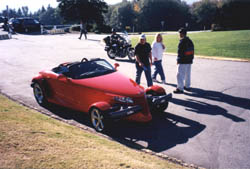 Expect to attract attention when you drive a Prowler. This is the author’s test car. |
From just about any angle, the Prowler’s wild styling is a feast for the eyes. Its tapered body and exposed front tires and wheels mimic the original ‘fenderless’ Ford and Chevy coupes of the 40’s and 50’s. To prevent wheel spray, the Prowler has small, front fenders that turn with the tires. Like early hot rods, the front tires and wheels are smaller than the rear tires and wheels – although it should be mentioned that the original hot-rods never had low-profile, high-speed, run-flat tires. The Prowler’s front tires are P225/45HR-17 inch, and the rears are P295/40HR-20 inch mounted on five-spoke silver, or optional chrome alloy wheels.
Rather than the separate headlamps common to hot-rods of the 40’s and 50’s, the Prowler has smaller projector beam headlamps under plastic covers cleverly integrated into the body behind the grille. The rear of the Prowler appears extremely wide and high, accented by wide rear tires and separate fenders, and twin exhaust pipes with chrome tips.
A common criticism of the Prowler’s styling are the large, protruding front bumpers. They’re necessary to meet 5 mph bumper standards and crash standards. Personally, I don’t find them offensive. The designers did a good job of making them look as inconspicuous as possible.
Well-Equipped Interior But Tiny Trunk
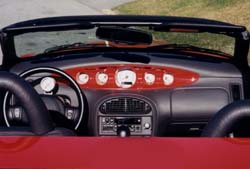
Inside the car, most of the instruments are positioned in the centre of the dashboard, including a large speedometer flanked by oil pressure, voltmeter, fuel and coolant gauges. The tachometer is positioned on the steering column just behind the steering wheel – just like they used to be on souped-up rods of yesteryear.
The rest of the interior is contemporary in design and very well-equipped. Standard equipment includes leather seats, air conditioning, AM/FM/cassette and a 6-disc CD changer with seven speakers, remote keyless entry, cruise control and power door locks. For safety, the Prowler has three-point seatbelts and dual airbags – the passenger side airbag has a key-operated cutoff switch. However, the Prowler doesn’t have a rollover bar or roll hoops.
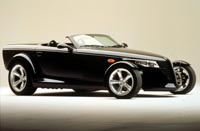
|
The black convertible top is manually-operated, and folds down into a cavity behind the seats under a plastic boot cover. It’s easy to do, but you have to get out of the car to raise and lower the top.
As far as storage space, the Prowler is probably the most impractical vehicle I’ve ever tested. Interior storage room is limited to a small, centre storage bin and a seatback map pocket, but there’s no glove box or door pockets. The Prowler has the smallest, shallowest trunk I’ve ever seen – a measly 1.8 cubic feet – not even enough room for an overnight bag.
Perhaps that’s why Chrysler recently unveiled a modified version of the Prowler called the ‘Howler’ at the SEMA (Specialty Equipment Marketing Association) trade show in Las Vegas. The Howler is a Prowler with a taller, longer tail and a usable trunk.
Another option is a special Prowler trailer which looks exactly like the Prowler from the rear.
Retro-look But High-tech Construction
Though it looks like it belongs in the 50’s, the Prowler is built using sophisticated 90’s technology. Extensive use of lightweight, rust-free aluminum includes a bonded and riveted aluminum frame, aluminum suspension components, aluminum engine, and some aluminum body panels (hood, doors, deck lid, and front side panels). The remaining body panels are a composite plastic material. A structural cross-member behind the instrument panel is made of magnesium.
Unlike early hot-rods which had solid front and rear axles, the Prowler has a fully independent suspension, including front double ‘A’ arm suspension with inboard-mounted spring and shock assembly, and rear an independent four-link setup. Four vented disc brakes with ABS are standard equipment.
The standard powerplant is the 3.5 litre SOHC 24 valve V6 engine that also powers the Chrysler LHS and 300M models. This all-aluminum engine develops 253 horsepower at 6,400 rpm (39 more than the previous 3.5 litre engine) and 255 foot pounds of torque at 3,950 rpm.
The Prowler is not available with a manual transmission, but it does offer Chrysler’s four-speed automatic ‘AutoStick’ transmission which allows both automatic or sequential manual shifting. To shift manually, the driver places the floor-mounted stickshift in the last gate, and pushes the lever right to change up and left to change down. If the driver fails to shift before the engine redline, the AutoStick transmission will shift automatically. To improve vehicle weight distribution, the AutoStick transaxle is mounted at the rear of the car.
A Whole Lotta Shakin’ Goin’ On
Though the Prowler looks like a cross between a hot-rod and a race-car, it’s not a handling machine. The Prowler’s wide track and super-wide, sticky tires provide excellent grip on smooth surfaces, but its unforgiving suspension and considerable body flex upset its balance when any small bump is encountered. In fact, the whole body shakes alarmingly when travelling over larger bumps, and from the driver’s seat, is rather disconcerting.
In true hot-rod tradition, the Prowler’s straight-line acceleration is very quick, in part because the Prowler weighs just 1287 kg (2838 lb). However, the transmission, in automatic mode, ‘bumps’ when it changes gears – I don’t know why because this same transmission is very smooth on other Chrysler vehicles. In manual mode, the AutoStick transmission allows manual shifting, but there’s a slight delay in the actuation.
Braking is excellent, as you would expect in a lightweight vehicle with four wheel disc brakes, and the power-assisted steering has good feel and responsiveness.
Wind buffeting with the top down is minimal due to a well-raked windshield and fairly high door sides. With the top up, visibility to the rear is impaired, but the top is well-sealed against the elements. In any event, the Prowler is more of a summer car – I don’t even know if you could get 20 inch snow tires…
MSRP of $61,000
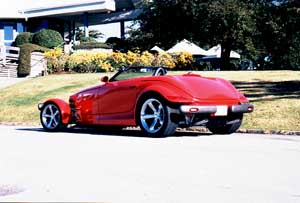
The Manufacturer’s Suggested Retail Price for the 2000 Prowler is $61,000, up from $55,000 in 1999. Plus, there’s a $1400 delivery charge. In some areas, you might find dealers asking more than that because the Prowler is a limited production specialty car in high demand. In calendar year 1998, only 146 Prowlers were sold in Canada, and in 1999, 88 have been sold to date. Worldwide production output for the 1999 model year was only about 5000 units.
Still, with its high resale value, the Prowler might be a good investment, and one with which you can have a lot of fun.
You can find out more information about the Prowler on the internet at plymouthcars.com and prowlerclub.com
Technical Data:
|
||||||||||||||||||||||||||||||||||||||






